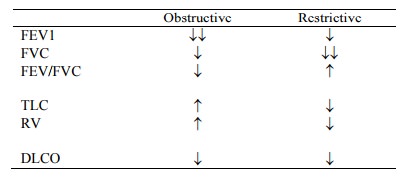Chapter: Medicine Study Notes : Respiratory
Lung Function Tests - Physiology
Lung Function Tests

·
Definitions:
o PEFR = peak expiratory flow rate
o FEV1.0 = maximum volume of air that can be exhaled during the first
second of a Forced Vital Capacity (FVC= maximum expired volume = FV). May use
SVC if its higher
§ Normally 80% of FVC
§ < 75% Þ obstructive lung disease
§ > 75% Þ restrictive lung disease, eg lung fibrosis, neuro-muscular disease,
chronic PEs (® scarring) and heart failure
§ But this can lead you astray. Eg if bronchodilator ® FVC by
more than FEV, then the ratio drops
o FEV 25-75%: Mean forced expiratory flow from 25 to 75% of vital capacity
= Mean Mid-expiratory Flow (MMEF). Gets rid of peak flow which is very effort
dependent ® more reliable measure
·
VC = vital capacity:
o FVC: forced vital capacity
o SVC: slow vital capacity
·
FIF50%: Forced inspiratory flow
at 50% of vital capacity
·
PIFR: Peak inspiratory flow rate
·
Patterns:

·
Diffusing Capacity: DL CO:
Diffusing capacity of the lung for Carbon Monoxide (needs adjustment for Hb –
eg anaemia, polycythaemia)
·
Performing Lung Function Tests:
o Requires at least 3 manoeuvres, the best two having FEV1.0‟s and FVCs
within 5% of each other
o Biggest problems with serial reproducibility are obtaining maximum
inspiration first, and getting maximum effort
o All are reported at BTPS (body temperature, saturated)
o If assessing broncho-dilator responsiveness, should have no inhaler for
2 hours before hand. Maximum responsiveness usually 20 minutes after dosing
o Predicted values are based on age, height and sex. Different racial
groups and people with varying proportions (eg long legs/short torso) may be
very poorly approximated by predicted values
o Flow-volume Loop gives very valuable information. Eg in emphysema, ¯¯expiratory
flows but inspiratory flows normal
· Patterns of disease:
o Obstruction: ¯flow
o Restrictive: ¯volume
·
Other lung function tests:
o Asthma provocation: for pilots, divers, police, etc
o Cardiopulmonary exercise testing – finds how much of shortness of breath
is due to pulmonary causes and how much to cardiac causes
Related Topics